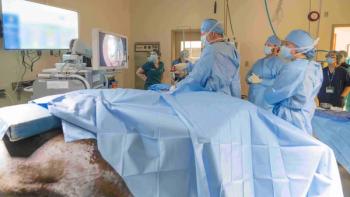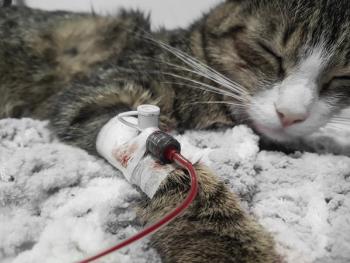
Have You Heard? A fast and effective gastropexy alternative for GDV prevention? (script)
Despite numerous critical care advances and increased pet owner awareness, gastric dilatation-volvulus (GDV) is still associated with high morbidity and mortality.
Despite numerous critical care advances and increased pet owner awareness, gastric dilatation-volvulus (GDV) is still associated with high morbidity and mortality. Some veterinarians advocate prophylactic gastropexy for their high-risk patients, such as large deep-chested Great Danes and Dobermans and extremely nervous or rapid eaters. In female dogs, this procedure is often a relatively easy addition to a routine ovariohysterectomy, but for male and female dogs that are not scheduled for abdominal surgery, a gastropexy to prevent GDV is frequently not performed.
(GETTY IMAGES)
Until recently, the only options for the procedure were an open surgical or a laparoscopic technique. The risks and recovery time associated with an open approach discourage many veterinarians from recommending this elective procedure, and the expensive equipment, procedure duration, and advanced training required for a laparoscopic technique make it less desirable as well. However, researchers recently evaluated a new approach to preventing GDV—endoscopically assisted gastropexy.
The study included 24 client-owned dogs selected based on their increased risk for developing GDV and their healthy status as assessed by a complete blood count and serum chemistry profile. The dogs represented a wide variety of breeds, and their ages ranged from under 1 year to over 8 years old; the median patient age was 2 years. The patients were surgically prepared and anesthetized following routine protocols and monitored throughout the procedure.
Endoscopically assisted gastropexy involves insufflation of the stomach along with endoscopic visualization of stomach anatomy. Stay sutures were placed and pulled taut from outside the body behind the 13th rib, and appropriate suture placement was confirmed endoscopically. An incision was made between the stay sutures through the skin, subcutaneous tissue, and abdominal musculature; the tissue was then dissected until the stomach was visible. The stomach was incised through the serosal and muscular layers of the pyloric antrum and sutured to the body wall before incision closure, stay suture removal, and stomach evaluation and decompression. The patients were routinely recovered, and hydromorphone was administered to control pain. The dogs were hospitalized overnight, and tramadol was prescribed at discharge to be given for three to five days for analgesia.
The success of the procedure was evaluated laparoscopically one month after surgery in about half the dogs and six months after surgery in the remainder. Owners were contacted and surveyed at least one year after the surgery. All the dogs recovered well, and none had experienced GDV. Laparoscopically, all of the gastropexies were in place at the pyloric antrum, and the adhesions appeared strong. Biopsy specimens all showed mature scarring at the gastropexy sites.
Although experienced surgeons performed the procedure in this study, they have taught the technique to other surgeons and think that most can become proficient after completing a few procedures. In addition to being minimally invasive, endoscopically assisted gastropexy is safe, reliable, and fast, taking about 20 minutes of surgical time. This study was limited in size and follow-up time, so more research should be done to identify potential difficulties associated with the technique. But endoscopically assisted gastropexy appears to be a promising procedure to prevent GDV in high-risk dogs.
Source: Dujowich M, Keller ME, Reimer SB. Evaluation of short- and long-term complications after endoscopically assisted gastropexy in dogs. J Am Vet Med Assoc 2010;236(2):177-182.
Newsletter
From exam room tips to practice management insights, get trusted veterinary news delivered straight to your inbox—subscribe to dvm360.




